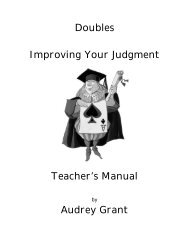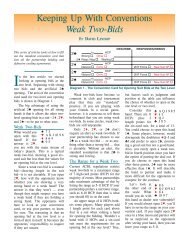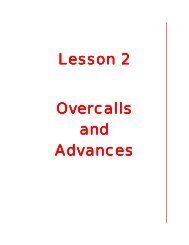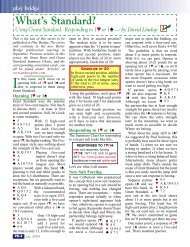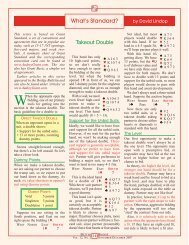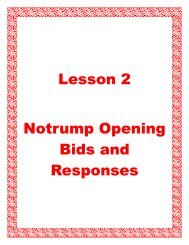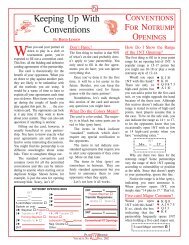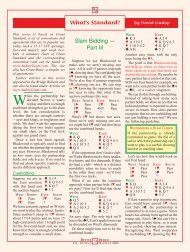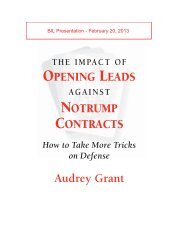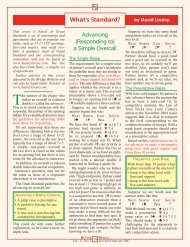Handling Opponents' Doubles & Preempts - Better Bridge
Handling Opponents' Doubles & Preempts - Better Bridge
Handling Opponents' Doubles & Preempts - Better Bridge
Create successful ePaper yourself
Turn your PDF publications into a flip-book with our unique Google optimized e-Paper software.
play bridge<br />
Keeping Up With Conventions<br />
<strong>Handling</strong> Opponents’ <strong>Doubles</strong> & <strong>Preempts</strong> — by David Lindop<br />
This series of articles looks at how<br />
to fill out the standard convention<br />
card. Previous articles can be found<br />
by visiting the <strong>Better</strong> <strong>Bridge</strong> News<br />
section at www.Audrey Grant.com.<br />
We’re getting near the end of<br />
this series of articles. This<br />
month we’ll take a look at<br />
a variety of topics on the back (left)<br />
side of the convention card.<br />
When an Opponent <strong>Doubles</strong><br />
Partner opens 1♦ and<br />
the opponent on your<br />
right doubles. What<br />
do you respond with<br />
this hand<br />
If you would respond 2♣, your<br />
partnership agreement is to simply<br />
ignore the double and make your<br />
normal response. After all, the<br />
double hasn’t taken up any of your<br />
bidding room. That’s fine, but most<br />
partnerships change the meaning of<br />
responder’s bids after an opponent<br />
makes a takeout double. That’s dealt<br />
with on this section on the card:<br />
OVER OPP’S T/O DOUBLE<br />
New Suit Forcing: 1 level □ 2 level □<br />
Jump Shift: Forcing □ Inv. □ Weak □<br />
Redouble implies no fit □<br />
2NT Over Limit+ Limit Weak<br />
Majors □ □ □<br />
Minors □ □ □<br />
Other<br />
This section only applies if partner<br />
opens 1♣, 1♦, 1♥, or 1♠ and the<br />
next player doubles. If partner’s 1NT<br />
opening bid is doubled, for example,<br />
the meaning of responder’s calls<br />
is handled in the section on<br />
NOTRUMP OPENING BIDS.<br />
Why is it common to change the<br />
meaning of responder’s bids after a<br />
takeout double It centers on the fact<br />
that responder has a new call available<br />
after the double: the redouble.<br />
PB-4 July, 2003<br />
♠ K 10 3<br />
♥ 9 4<br />
♦ K9 2<br />
♣ AQJ 7 5<br />
The Redouble<br />
The standard agreement is that a<br />
redouble shows about 10 or more<br />
high-card points. It essentially says,<br />
“This is our hand, partner.” You<br />
might redouble with the intention of<br />
doubling the opponents for penalty<br />
in whichever contract they choose;<br />
you might be planning to show a<br />
good suit of your own; or you might<br />
be planning to support partner.<br />
With this agreement, you would<br />
redouble with this hand. Suppose you<br />
are South and the auction continued:<br />
WEST NORTH EAST SOUTH<br />
1♦ Double Redouble<br />
2♣ Pass Pass <br />
You could now double for penalty.<br />
You would also double for penalty if<br />
the opponents bid notrump.<br />
Suppose the auction went:<br />
WEST NORTH EAST SOUTH<br />
1♦ Double Redouble<br />
Pass Pass 1♥ <br />
You could now bid 2♣. This would<br />
be forcing, showing the same type of<br />
hand that you would have responded<br />
2♣ if there had been no double.<br />
What if the auction went this way:<br />
WEST NORTH EAST SOUTH<br />
1♦ Double Redouble<br />
Pass Pass 1♠ <br />
You don’t have quite enough in<br />
spades to double, so you could bid<br />
2♣ as before. Alternatively, you<br />
could pass and see if partner wants to<br />
double 1♠. You might then choose to<br />
defend for penalty, especially if the<br />
opponents are vulnerable.<br />
The point is that your pass in this<br />
situation would be forcing. Your<br />
redouble announced that the deal<br />
belonged to your side, so the partnership<br />
will either bid to its best<br />
contract or double the opponents if<br />
they get overboard.<br />
The real impact of the redouble,<br />
however, is how it colors the meaning<br />
of responder’s other bids.<br />
Responder’s New Suit<br />
What call do you<br />
make with this hand<br />
if partner opens 1♦<br />
and the next player<br />
doubles<br />
If your right-hand opponent had<br />
passed, you would have to respond<br />
1NT since you don’t have enough<br />
strength to bid a new suit at the two<br />
level. A new suit response would be<br />
forcing and you might get too high.<br />
After the double, however, you can<br />
respond 2♣. This is no longer forcing<br />
because you would have started with<br />
a redouble with enough strength to<br />
bid a new suit at the two level.<br />
Strangely enough, although it is<br />
common to agree that a new suit at<br />
the two level is non forcing after an<br />
opponent’s takeout double, a new<br />
suit at the one level is usually treated<br />
as forcing. Why<br />
Suppose partner opens<br />
the bidding 1♦, the<br />
next player doubles,<br />
and you have this hand.<br />
<br />
♠ J 8 5<br />
♥ 9 4<br />
♦ 7 3<br />
♣ KQJ 7 5 3<br />
♠ 7 3<br />
♥ AJ 7 5<br />
♦ A J 9 5<br />
♣ 7 4 3<br />
You have enough to redouble but<br />
the auction may become awkward if<br />
the opponents bid spades. You don’t<br />
want to introduce a four-card heart<br />
suit at the two level or higher but also<br />
don’t want to miss a heart fit if you<br />
have one. You may have a heart fit<br />
despite the takeout double since the<br />
doubler doesn’t always have four<br />
cards in an unbid suit. It’s more<br />
effective to make a forcing response<br />
of 1♥, planning to show the diamond<br />
support next if partner doesn’t like<br />
hearts ... exactly what you would<br />
have done without the double.<br />
So, you would typically mark the<br />
convention card like this:<br />
New Suit Forcing: 1 level □ 2 level □<br />
This indicates that after a takeout<br />
double a new suit at the one level is<br />
still forcing but a new suit at the two<br />
level is non forcing.
The Jump Shift<br />
You will rarely hold a hand strong<br />
enough to make a standard jump<br />
shift—about 17 or more points—<br />
when partner opens one of a suit<br />
and the next player doubles. If you<br />
do, you can always start with a<br />
redouble. So, most partnerships<br />
would treat a jump in a new suit by<br />
responder as non forcing after a<br />
takeout double.<br />
Suppose partner<br />
opens 1♦, the next<br />
player doubles, and<br />
you have this hand.<br />
You could respond<br />
1♠, forcing—a new suit at the one<br />
level. However, some players prefer<br />
to jump to 2♠ with this type of hand,<br />
as a weak, preemptive response. If<br />
that’s your style, you would check<br />
the “Weak” box beside Jump Shift. If<br />
you would hold a more invitational<br />
hand for a jump to 2♠, you would<br />
check the “Inv.” box; if a jump to 2♠<br />
would still be forcing, you would<br />
check the “Forcing” box.<br />
Preemptive Jump Raises<br />
Suppose partner<br />
opens 1♥, the next<br />
player doubles and<br />
this is your hand.<br />
What call do you<br />
make Nobody could quarrel with a<br />
simple raise to 2♥, but the modern<br />
style is to make a weak jump raise<br />
to 3♥ with this hand. This preemptive<br />
bid is designed to make it more<br />
difficult for the opponents to compete<br />
to their best spot while being<br />
reasonably safe since your side<br />
must have at least a nine-card fit.<br />
This is such a standard treatment<br />
that you don’t need to mark it on the<br />
convention card. Again, it comes<br />
back to availability of the redouble.<br />
With the values for a limit raise to<br />
3♥, you could start with a redouble.<br />
Dormer/Jordan/Truscott 2NT<br />
But should you redouble<br />
with a fit for partner<br />
Suppose partner’s 1♥<br />
opening bid is doubled<br />
and you have this hand.<br />
♠ Q J 10 8 7 5<br />
♥ 7 3<br />
♦ J 10 3<br />
♣ 6 4<br />
♠ 5<br />
♥ Q 10 7 5<br />
♦ Q 10 7 4 3<br />
♣ 8 4 2<br />
♠ 8 3<br />
♥ AQ 7 5<br />
♦ KJ 6 2<br />
♣ 7 5 3<br />
With 10 high-card points you<br />
have enough to redouble, but what<br />
will you do if the auction continues:<br />
WEST NORTH EAST SOUTH<br />
1♥ Double Redouble<br />
2♠ Pass 3♠ <br />
You don’t want to double the opponents<br />
for penalty when you have<br />
such a good fit for partner, but to<br />
show the fit you would have to bid<br />
4♥ which might be too much.<br />
To get around this dilemma,<br />
many partnerships use a jump to<br />
2NT to show the values for a limit<br />
raise of partner’s suit after a takeout<br />
double. Partner can return to three<br />
of the agreed suit with a minimum,<br />
or bid game with enough strength to<br />
accept an invitational raise.<br />
This convention goes by a variety<br />
of names: Dormer, Jordan, or<br />
Truscott. If you agree to use this<br />
convention, you would mark the<br />
convention card like this:<br />
Redouble implies no fit □<br />
2NT Over Limit+ Limit Weak<br />
Majors □ □<br />
□<br />
<br />
By checking both boxes in the<br />
column under “Limit” you indicate<br />
that 2NT shows a limit raise after a<br />
double if partner opens either a<br />
major suit or a minor suit. Notice<br />
that you would also check the box<br />
beside “Redouble implies no fit”<br />
because you would usually bid 2NT<br />
with a fit. You might redouble with<br />
three-card support since a limit raise<br />
typically implies four-card support.<br />
If you would bid 2NT over a<br />
double with 13 or more points and<br />
support—planning to continue to<br />
game anyway if partner rebids three<br />
of the suit—you would check the<br />
boxes under “Limit+” indicating<br />
that 2NT shows the strength for a<br />
limit raise or better.<br />
Some partnerships prefer to keep<br />
the jump to the three level as the<br />
limit raise and to use 2NT to show a<br />
preemptive raise—typically after a<br />
minor-suit opening only. They<br />
would check the box(es) in the third<br />
column.<br />
When an Opponent <strong>Preempts</strong><br />
Suppose you have<br />
this hand and the<br />
opponent on your<br />
right opens with a<br />
weak 2♥ bid. What<br />
call do you make<br />
play bridge<br />
♠ KQ 10 8<br />
♥ 4<br />
♦ AQ 7 5<br />
♣ K J 6 3<br />
Practically everyone would make<br />
a takeout double with this hand.<br />
What if the opening bid were 3♥ A<br />
takeout double would still be the<br />
standout choice. What if your righthand<br />
opponent opens 4♥ Now<br />
we’re getting into a grey area.<br />
Would a double be for takeout or for<br />
penalty Perhaps you would double<br />
anyway, not caring whether partner<br />
leaves the double in or takes it out.<br />
But what if the opening bid were<br />
4♠ You’d certainly like to double<br />
for penalty, but that wouldn’t work<br />
well if your partner thinks your double<br />
is for takeout and bids 5♥.<br />
The agreement on whether a<br />
double is for penalty or takeout is<br />
put in this section of the card:<br />
VS Opening <strong>Preempts</strong> Double Is<br />
Takeout □ thru Penalty □<br />
Conv. Takeout:<br />
Lebensohl 2NT Response □<br />
Other:<br />
The standard agreement is that a<br />
double of an opening preemptive<br />
suit bid below the game level—up<br />
to 4♦—is for takeout; a double of<br />
4♥ is optional ... partner can leave it<br />
in or take it out; a double of 4♠ or<br />
higher is for penalty. If that’s your<br />
partnership style, you would fill out<br />
the card something like this:<br />
Takeout □<br />
thru 4H<br />
Penalty □<br />
Some partnerships prefer using a<br />
double for takeout through 4♠ or<br />
higher. If that’s your agreement, you<br />
would mark the card appropriately.<br />
Since it is standard to use a double<br />
for takeout through at least the<br />
three level, you would check the<br />
“Penalty” box if you prefer to use<br />
the double of a weak two-bid or<br />
three-bid for penalty. You would<br />
also have to Alert the opponents.<br />
Vol. 7, No. 7 PB-5



